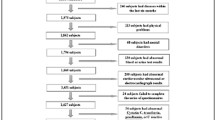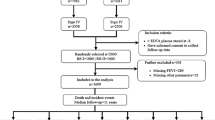Abstract
Background
Whereas chronological age (CA) cannot distinguish functional differences among individuals of the same age, the biological age (BA) may be used to reflect the functional state of the body. The purpose of this study was to construct an integral formula of the BA, by using principle component analysis (PCA).
Methods
The vital organ function of 505 healthy individuals of Han origin (age 35–91 years) was examined. A total of 114 indicators of cardiovascular, pulmonary, and brain functions, and clinical, inflammatory, genetic, psychological, and life habit factors were assessed as candidate indicators of aging. Candidate indicators were submitted with CA to correlation and redundancy analyses. The PCA method was used to build an integral formula of the BA for the population.
Results
Seven biomarkers were selected in accordance with a certain load standard. These biomarkers included the trail making test (TMT), pulse pressure (PP), mitral valve annulus ventricular septum of the peak velocity of early filling (MVES), minimum carotid artery intimalmedial thickness (IMTmin), maximum internal diameter of the carotid artery (Dmax), maximal midexpiratory flow rate 75/25 (MMEF75/25), and Cystatin C (CysC). The formula for the BA was: BA = 0.0685 (TMT) + 0.267 (PP)–1.375 (MVES) + 22.443 (IMTmin) + 2.962 (Dmax)–2.332 (MMEF75/25) + 16.104 (CysC) + 0.137 (CA) + 0.492.
Conclusion
Several genetic and lifestyle indicators were considered as candidate markers of aging. However, ultimately, only markers reflecting the function of the vital organs were included in the BA formula. This study represents a useful attempt to employ multiple indicators to build a comprehensive BA evaluation formula of aging populations.
Similar content being viewed by others
References
Hekimi S (2006) How genetic analysis tests theories of animal aging. Nature genetics 38:985–991.
Kirkwood TBL, Austad SN (2000) Why do we age? NATURE-LONDON 233–238.
Gunn DA, Rexbye H, Griffiths CEM et al (2009) Why some women look young for their age. PloS one 4:e8021.
Invidia L, Salvioli S, Altilia S, et al (2010) The frequency of Klotho KL-VS polymorphism in a large Italian population, from young subjects to centenarians, suggests the presence of specific time windows for its effect. Biogerontology 11:67–73.
Wahlin Å, MacDonald SWS, de Frias CM, et al (2006) How do health and biological age influence chronological age and sex differences in cognitive aging: moderating, mediating, or both? Psychology and Aging 21:318.
Majkić-Singh N (2011) What is a Biomarker? From its Discovery to Clinical Application.
Klemera P, Doubal S (2006) A new approach to the concept and computation of biological age. Mechanisms of ageing and development 127:240–248.
Nakamura E, Miyao K (2008) Sex differences in human biological aging. The Journals of Gerontology Series A: Biological Sciences and Medical Sciences 63:936–944.
Park JH, Cho BL, Kwon HT, et al (2009) Developing a biological age assessment equation using principal component analysis and clinical biomarkers of aging in Korean men. Archives of gerontology and geriatrics 49:7–12.
Bai X, Han L, Liu Q, et al (2010) Evaluation of Biological Aging Process-A Population-Based Study of Healthy People in China. Gerontology 56:129–140.
AihieSayer A, Osmond C, Briggs R, et al (1999) Do all systems age together? Gerontology 45:83–86.
Shibata S, Levine BD (2006) Biological aortic age derived from the arterial pressure waveform. Journal of Applied Physiology 110:981–987.
Ahammer IM, Baltes PB (1972) Objective versus perceived age differences in personality: how do adolescents, adults, and older people view themselves and each other? Journal of Gerontology.
Barak B, Schiffman LG (1981) Cognitive age: A nonchronological age variable. Advances in consumer research 8:602–606.
Jones DM, Song X, Rockwood K (2004) Operationalizing a frailty index from a standardized comprehensive geriatric assessment. Journal of the American Geriatrics Society 52:1929–1933.
Bae CY, Kang YG, Kim S (2008) Development of models for predicting biological age (BA) with physical, biochemical, and hormonal parameters. Archives of gerontology and geriatrics 47:253–265.
Grubb A, Björk J, Nyman U (2011) Cystatin C, a marker for successful aging and glomerular filtration rate, is not influenced by inflammation. Scandinavian Journal of Clinical & Laboratory Investigation 71:145–149.
Odden MC, Tager IB, Gansevoort RT (2010) Age and cystatin C in healthy adults: a collaborative study. Nephrology Dialysis Transplantation 25:463–469.
Odden MC, Chertow GM, Fried LF (2006) Cystatin C and measures of physical function in elderly adults. American journal of epidemiology 164:1180–1189.
Tombaugh TN (2004) Trail Making Test A and B: Normative data stratified by age and education. Archives of Clinical Neuropsychology 19:203–214.
Sprott RL (2010) Biomarkers of aging and disease: introduction and definitions. Experimental gerontology 45:2–4.
Butler RN, Sprott R, Warner H, et al (2004) Biomarkers of aging: from primitive organisms to humans. JOURNALS OF GERONTOLOGY SERIES A 59:560–567.
Kenyon CJ. The genetics of ageing. Nature 464:504–12.
Csiszar A, Labinskyy N, Jimenez R, et al (2009) Anti-oxidative and antiinflammatory vasoprotective effects of caloric restriction in aging: role of circulating factors and SIRT1. Mechanisms of ageing and development 130:518–527.
Salminen A, Kaarniranta K (2010) Insulin/IGF-1 paradox of aging: Regulation via AKT/IKK/NF-[kappa] B signaling. Cellular signalling 22:573–577.
Coppé JP, Rodier F, Patil CK, et al (2011) Tumor suppressor and aging biomarker p16INK4a induces cellular senescence without the associated inflammatory secretory phenotype. Journal of Biological Chemistry 286:36396–36403.
de Gonzalo-Calvo D, Neitzert K, Fernández M, et al (2010) Differential inflammatory responses in aging and disease: TNF-α and IL-6 as possible biomarkers. Free Radical Biology and Medicine 49:733–737.
Christensen K, Johnson TE, Vaupel JW (2006) The quest for genetic determinants of human longevity: challenges and insights. Nature Reviews Genetics 7:436–448.
Kuro-o M (2009) Klotho and aging. Biochimica et Biophysica Acta (BBA)-General Subjects 1790:1049–1058.
Author information
Authors and Affiliations
Corresponding author
Rights and permissions
About this article
Cite this article
Zhang, W.G., Bai, X.J., Sun, X.F. et al. Construction of an integral formula of biological age for a healthy Chinese population using principle component analysis. J Nutr Health Aging 18, 137–142 (2014). https://doi.org/10.1007/s12603-013-0345-8
Received:
Accepted:
Published:
Issue Date:
DOI: https://doi.org/10.1007/s12603-013-0345-8




